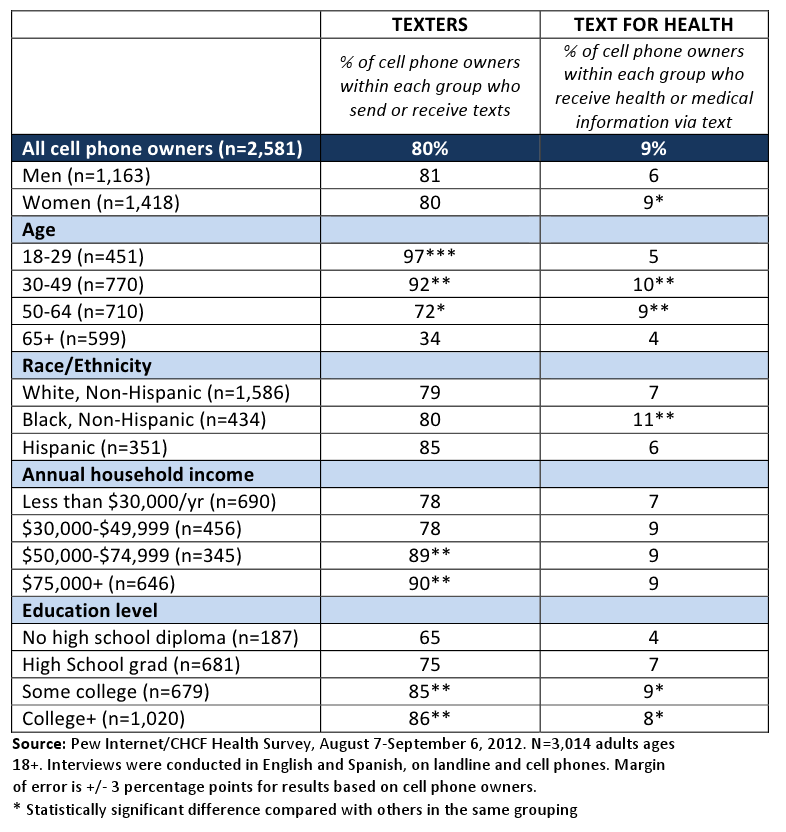 The recent Pew Internet Project study reported that only 9 percent of American adults use texting to get health updates, although 80 percent use text messaging. As app adoption stagnates, some start-ups, like California-based HealthCrowd, are hitching their wagon to mobile messaging, including text messaging, rather than apps, as the future of patient engagement.
The recent Pew Internet Project study reported that only 9 percent of American adults use texting to get health updates, although 80 percent use text messaging. As app adoption stagnates, some start-ups, like California-based HealthCrowd, are hitching their wagon to mobile messaging, including text messaging, rather than apps, as the future of patient engagement.
“There are too many apps out there, and you don’t know which ones are any good,” HealthCrowd co-founder and CEO Neng Bing Doh told MobiHealthNews in a recent interview. “It’s too much work to find one, and then it’s more work to download it, and it’s more work to use it.”
HealthCrowd sells health-related messaging systems to health plans and care providers, which can use them for communications & outreach, chronic disease management, discharge follow-up, and behavioral health support. For instance, one HealthCrowd intervention for recovering alcoholics involved texting a person's friends to remind them to congratulate him on a "sobriety birthday."
The company's team comes from a mix of health and engineering backgrounds; Bing spent five years in online advertising. She says the practices in that field inspired her to do health-related messaging in a new way: targeting and tailoring messages the way Google targets ads.
“What everybody else does today is they send text messages. They have a doctor or clinician write the text messages, and then they farm out these messages to the entire world and they expect people to respond to them,” Doh said. “For each action that we study, we’ve got thousands of different variations of the same message. … If you don’t find a way to touch someone, make them laugh, whatever it is, you won’t get them to respond.”
Bing says the demographic that engages the most with the messages isn’t quite who you’d expect.
“When people first hear about our solution they say it’s perfect for teenagers,” she said. “That’s not true and I’ll tell you why. They grew up on texting. It’s not novel, it’s not interesting. It’s how they communicate. You have to take it up a notch. You have to find a better way to reach out to them. But the older folks, text messaging is novel, they don’t get many texts.”
HealthCrowd’s approach seems to get results. For instance, Bing says preliminary results from a pilot study with a University of Iowa Hospitals and Clinics cardiac rehab program were promising. Compared to non-text message enrolled participants, four times as many HealthCrowd users showed up at a 3-month follow-up appointment and twice as many completed the 6-month program. The patients texted back to 30 to 40 percent of the messages they received.
According to Doh, the company's business model, charging health care organizations per member per month, has worked well for the company so far, particularly working with Medicaid populations. There’s one other advantage to engagement via messaging –- it skirts the need for FDA clearance.
“We don’t diagnose, we don’t practice,” said Doh, noting that right now the service is opt-in for the customer, which alleviates some potential privacy concerns. “We use the power of messaging to reach people, to get them to do things.”
Doh compared HealthCrowd's program to Bosch Healthcare's Health Buddy product, which uses a specially-made device to deliver health messages. Doh says they do "exactly the same thing" -- but cheaper, and without the need for a dedicated device.













